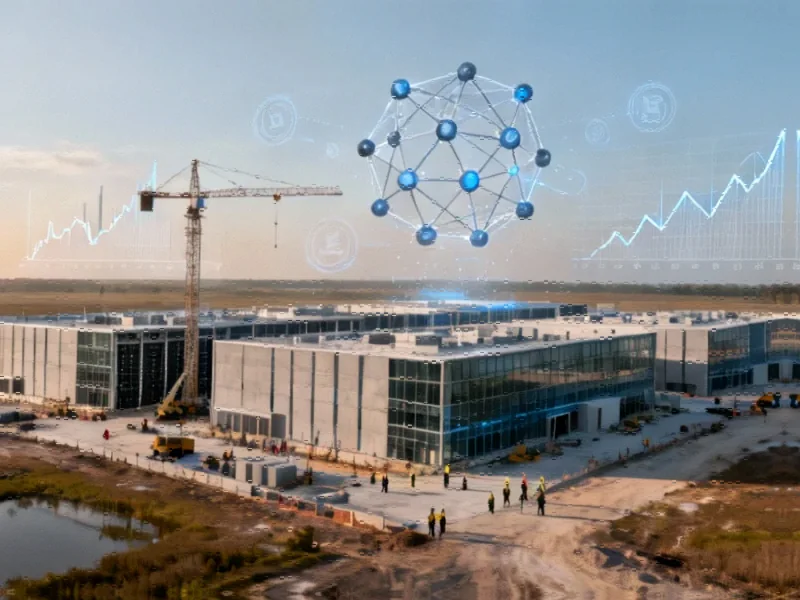Strategic Financing Partnership
In a landmark deal that redefines how tech giants fund massive infrastructure projects, Meta Platforms has secured approximately $30 billion in financing from private equity firm Blue Owl Capital for its Hyperion datacenter development in Louisiana. The innovative financing structure, arranged through Morgan Stanley’s investment banking expertise, represents one of the largest single-project financings in digital infrastructure history.
The agreement comprises roughly $27 billion in debt financing alongside $1.5 billion in equity investment, creating a template that other technology companies may follow as they scale their artificial intelligence capabilities. What makes this arrangement particularly noteworthy is how Meta will retain only a 20 percent stake while keeping the substantial debt obligation off its corporate balance sheet—a strategic move that provides financial flexibility while enabling aggressive expansion.
Hyperion’s Evolving Scale and Ambition
When Meta first announced the Richland Parish project in December, the four million square-foot campus was projected to cost approximately $10 billion. However, as CEO Mark Zuckerberg’s AI ambitions have intensified, the project’s scope has expanded dramatically. The facility is now expected to reach five gigawatts of total compute capacity, positioning it among the largest dedicated AI datacenter projects globally.
The scale-up reflects Meta’s urgent need for computational resources to compete in the rapidly accelerating artificial intelligence race. This expansion mirrors broader industry developments where infrastructure titans are making massive bets on AI capabilities. The Hyperion facility represents a critical component of Meta’s strategy to close the computational gap with competitors while supporting its evolving AI-driven product roadmap.
Power Infrastructure Demands
Supporting such massive computational requirements demands unprecedented energy infrastructure. For the initial build-out phase, Meta has commissioned local utility operator Entergy to construct a new natural gas generator plant featuring three combined cycle combustion turbine generators with total capacity exceeding 2.2 gigawatts.
This power solution highlights the ongoing tension between AI’s massive energy demands and environmental considerations, a challenge facing the entire technology sector. The situation reflects how the AI boom continues to drive natural gas expansion despite environmental concerns across multiple industries. The energy-intensive nature of AI training and inference workloads necessitates reliable, high-capacity power sources that can be deployed rapidly to meet aggressive timelines.
Broader Infrastructure Expansion Context
Hyperion represents just one component of Meta’s comprehensive datacenter expansion strategy. The company recently announced another gigawatt-scale facility in El Paso, Texas, and is advancing its Prometheus datacenter development in Ohio, expected to become operational next year. This multi-pronged approach ensures Meta can distribute computational workloads geographically while accessing diverse energy markets and talent pools.
The financing structure with Blue Owl could establish a precedent for how technology companies fund capital-intensive infrastructure projects without straining their balance sheets. As recent technology advancements continue to push computational boundaries, the industry may see more creative financing solutions emerge to support the enormous capital requirements of AI infrastructure.
Strategic Implications and Industry Impact
This deal arrives at a critical juncture for the technology sector, where computational capacity has become a strategic differentiator. By securing $30 billion in dedicated financing while maintaining operational control, Meta achieves multiple objectives: preserving corporate financial health, accelerating infrastructure deployment, and signaling serious commitment to AI leadership.
The arrangement also demonstrates private equity’s growing appetite for digital infrastructure investments, particularly projects with long-term, credit-worthy anchor tenants. As companies navigate evolving market trends and geopolitical considerations, such partnerships may become increasingly common for funding the massive infrastructure required to support next-generation technologies.
With the Hyperion facility scheduled to come online in 2029 and the debt structured to mature in 2049, this project represents a long-term strategic bet on AI’s enduring importance. The fully amortizing debt structure provides predictable financing costs while the lease-back arrangement ensures Meta maintains operational control over critical infrastructure.
As the AI infrastructure race intensifies, Meta’s Hyperion financing could become a blueprint for how technology giants balance ambitious expansion with financial prudence, potentially influencing how future mega-projects across the technology sector are funded and structured.
This article aggregates information from publicly available sources. All trademarks and copyrights belong to their respective owners.
Note: Featured image is for illustrative purposes only and does not represent any specific product, service, or entity mentioned in this article.



